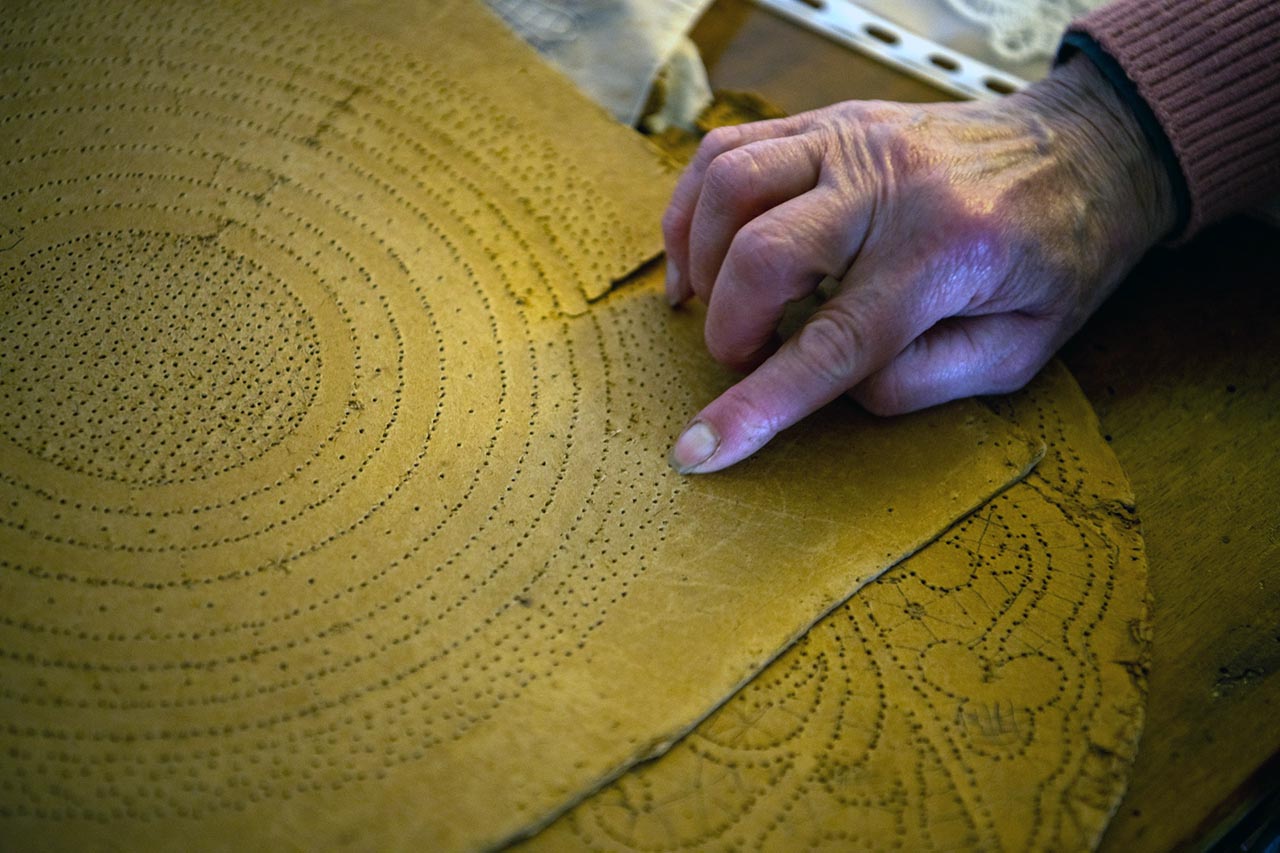In Positano, the Tombolo tradition is still alive and handed down thanks to the persistence of a group of women.
March 16th, 2021.By Saveria Fiore, photo by Vito Fusco
“The nimble fingers of the little girls working with hundreds of spools make you dizzy, but they raise their heads quietly, laugh, and chat as if they have no awareness of their magical fingers. Some works are stunning. I saw a tablecloth, a spider’s web as tangled as a thought. Fifty girls had worked on it for a year.“John Steinbeck, writer, frequent visitor, and lover of Positano, impeccably paints the art of bobbin lace in this sweet casket of handed-down traditions.

The plot of inspiration
A thousand threads meet. With small dance steps, they jump over each other. They hug, then choke in knots. They are walking towards a metamorphosis. Without knowing it, they are suddenly drawings born from the elegant inspiration of a woman. No, it is not the fates who weave the strings of destiny but the women who guard the Tombolo’art. Cardboard is applied to a cylindrical pillow (also called a Tombolo).
A dotted design and countless bobbins to weave (up to hundreds, depending on the embroidery to be reproduced). A picture framed by the patient skill of a woman who seems predisposed to play an instrument and enchants whoever receives her notes. The Tombolo is a silent, meticulous melody, an ancient art that still finds its precise location, neither physically nor in a temporal sense.
From country to country
Disputed between Germany, France, Italy, and Flanders, the Tombolo had already found its primitive bone spindles in Etruscan tombs. A practice born initially within the aristocracy, it soon spread even among the less well-to-do classes, albeit with more rudimentary tools (we are talking about bobbins made from animal bones and fish bones used as pins ).
Yet, Italy seems to claim its birth, with the first written records dating back to the 1400s and testifying its spread among the Italian population. Naples’s most flourishing production seems to spring just under the Aragonese period. However, this practice was a source of artistic pride even under the Bourbons.

Art that never goes out of fashion
Especially in the south, this fossil of rare beauty manages to reach us intact, even after the industrialization processes. The soul of Tombolo art lives right in the tangled and romantic nature of its manual creation, in the inheritance of mother to daughter.
At that time, this precious workforce was a possibility of earning for women, both for the house and themselves. The lace made with the Tombolo was an appreciated ornament that embellished women’s delicate dresses and a necessary component in the venture brides’ outfits, representing their dowry.

The Neapolitan tradition
This activity is still alive in Campania and in many towns of Irpinia and Salerno. Positano, for example, between 1800 and 1900, was already known for silk and canvas production: the classic jute cloth used in sacks. However, it stands out for the art of lace and embroidery between 1945-1950, thanks to the Sisters of Charity or Vincentians (because they took the model of San Vincenzo de Paoli).
In the ’50s, the Sisters initiated the little girls into lacemaking. Even when industrialization pressed on and the Sisters moved elsewhere, this technique has been handed down between generations, within families, and in craft shops.

The Positano way
The art of bobbin lacemaking has been proposed several times as a candidate for the intangible heritage of Unesco. In Italy, already rich in traditions, disseminating the technique is equivalent to an evangelization task, which leads us back to the Sisters of Charity. Artisanship is still alive thanks to Maria Cinque’s efforts in Positano, 60 years old. Maria has been carrying on her passion since she was a six or seven-year-old girl.
Today she hands it down within a local circle of willing apprentices (including the affectionate Maria Arpino and Rosalba Satriano) to her young daughter and her little grandchildren. They perceive all the feelings of their grandmother. “Left, left, center,” repeats the grandson to memorize the cloth point”. Until the ongoing pandemic stopped the meetings, a small group still gathered.

The economic value of embroidery
Maria began her journey with the elderly lady Talamo. The most adult, she was already 90 years old and still had the living energy to transmit, as if by infusion, this act of loving patience. Then she continued with Sister Angela when she was only 12 years old (previously, it was customary for the girls to learn to sew and embroider from the nuns).
Eduardo de Filippo himself and his brother often came to buy doilies from the nuns, proving to appreciate a work that only sensitive minds can truly understand. It is no coincidence that Maria confesses that she has never earned from this activity, but she has always preferred to give her work as a gift. “Most people – especially today – would not understand the real economic value for such painstaking labor,” tells Maria us.

The transmission of a passion
She didn’t know that she would become so skilled and teach it herself. “The greatest satisfaction is being able to bring out from my students the same love that guides me, every time, in the execution of the pillow,” says Maria hoping for future practical workshops that also include the lessons of Tombolo.
She humbly shows one of her most elaborate works, which kept her busy, day by day, from January to August: a doily (now framed) made of intertwining that look like verses from a poem. This poem’s composer is Maria, who continues the Tombolo art with the other women. Thanks to Maria, we will still hear in the air the faint ticking of the bobbins that wriggle in the prestigious play of fingers.
